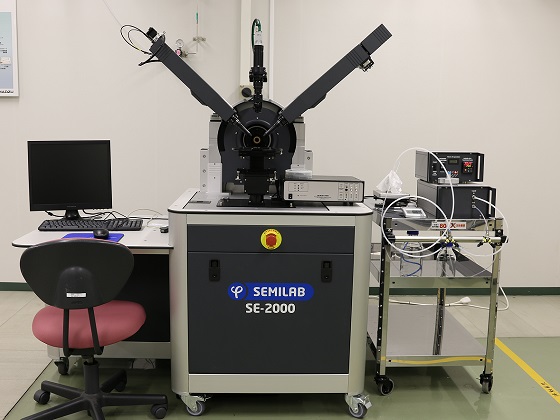Here's the text.
Ellipsomator
Last Updated January 4, 2019
Introduction of Elipsometer (ellipsometer)

Overview
Principles
When light is applied to the specimen, it is reflected on the surface of the specimen and produces reflective light. Reflected light can be divided into two components, p-polarization and s polarization, and this polarization state generally becomes an elliptical (Eli Pty Cal), so this kind of measurement method is called ellipsometry. By changing the wavelength of the light applied to the sample and measuring the phase difference Δ (delta) and the amplitude ratio of the reflected light to the sample, the optical constant and film thickness of the sample is evaluated.
Characteristics
Because it is an optical measurement, it can be measured without destructive and the measurement time is short, so it is possible not only to evaluate the resulting thin film but also process evaluation (In-situ measurement) of the thin film during fabrication. By selecting the wavelength of the light to be applied, it is also possible to evaluate the reflectivity, transmittance, band structure, and carryer density, etc.
Not good at
Because the reflected light is measured, the flatness of the surface is required. One-half of the wavelength of the light exposed is the limit. In addition, metal thin films that absorb light also has less reflected light, making it difficult to measure. Depending on the type of metal, the film thickness of about several hundred nm is the measurement limit. When multiple membranes are stacked, it is possible to measure the thickness of each film, but in this case, it is necessary to assume the interface layer that exists between the membrane and the membrane, so it is necessary to set up a model and perform calculation simulation. As a result, calculation may be complicated and difficult to interpret the results.
Equipment Performance and Specifications
Instrument model number: SE-2000 Nippon Semil Lab Co., Ltd.
Date of introduction: February, 2016
Charges
Membrane thickness and optical constant measurement 6,400 yen per sample
Charges
- Those that require special materials, labor, etc. for testing, analysis, or preparation, and the amount of fees for research or research shall be equivalent to actual costs.
- In particular, the amount of the fee or usage fee for use shall be double the amount specified.
- A person who has an office or office in Yokohama City.Small and medium-sized enterprises (external site) stipulated in Article 2 of the Small and Medium Enterprise Basic LawA person who does not have a fee pertaining to a request from other than or a city office or business establishment, and pertaining to film test by membrane thickness and optical constant measurement pertaining to requests from persons other than small and medium-sized enterprises specified in the same Article The amount of the fee is 1.3 times the specified amount (if there is a fraction less than 100 yen, the fractional amount is rounded up to 100 yen.) It's called.
For inquiries to this page
Small and Medium Enterprise Promotion Division, Small and Medium Enterprises, Economic Affairs Bureau
Phone: 045-671-4236
Phone: 045-671-4236
Fax: 045-664-4867
Email address: ke-keiei@city.yokohama.jp
Page ID: 794-207-885







